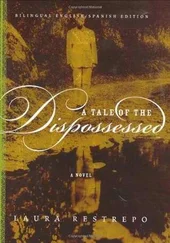I speak blindly about all this because I never met Sayonara personally. I learned the details of her life through the stories and memories of her people, particularly those of Todos los Santos, one of those monumental beings whom life grants us the privilege of getting to know. I forged a wonderful friendship with her through our many afternoons of conversation on Olguita’s patio, in the shade of the rubber trees, and because of that it would be absurd to call research, or reporting, or a novel, something that was a fascination on my part with a few people and their circumstances. Let’s just say that this book was born out of a chain of tiny revealed secrets that stripped the leaves, one by one, from Sayonara’s days, in an attempt to reach the pith.
Todos los Santos, Sacramento, Olguita, Machuca, and Fideo were extraordinary narrators, gifted with an astonishing ability to tell their tragedies without pathos and to speak of themselves without vanity, imprinting on the facts the intensity of those who are willing, for motives I still do not understand, to confess to a stranger for the sole reason that she writes, or because she’s precisely that, a stranger, or maybe because of the simple fact that she listens. As if the act itself of telling their own story to a third party would stamp it with a purpose, would make it somehow lasting, would clarify its meaning.
It was by accident that I entered the world of La Catunga. I was working against the clock on a report about a completely unrelated matter, the theft and clandestine distribution of gasoline by a criminal organization called the gasoline cartel, and because of that I landed in Tora on a Tuesday at eleven in the morning aboard a small plane belonging to the airline Aces. By two o’clock that afternoon Sayonara had already crossed my path, by pure chance but with a frightening obstinacy.
I needed a photograph of Sergeant Arias Cambises for my weekly magazine. He had been murdered six months earlier because he knew too much about the cartel’s operations, and I went to look for a photograph of him at the archives of the daily newspaper Vanguardia Petrolera . The young man in charge was just leaving for lunch, but he kindly allowed me to look around on my own.
“I’ll be back in half an hour,” he told me, and I went right to work.
I didn’t find what I was looking for in the alphabetical files, so I started rummaging around in the piles of unclassified material, a veritable Pandora’s box with a little of everything, except photos of Sergeant Arias Cambises: pictures of public disturbances, of bambuco composers hugging their guitars, teenage girls being presented to society, a demonstration in the twenties led by the famous labor leader María Cano, notable figures receiving awards, a native Charles Atlas called El Indio Amazónico, who swam underwater across the Río Magdalena. Even a litter of angora kittens playing with balls of yarn in a basket. Hundreds of photographs of all kinds and, suddenly, something that couldn’t be passed over.
It was a close-up of a mestiza girl of dark, biblical beauty, without makeup or adornment, who breathed an air of virgin jungles and at the same time of unfathomed depths, a truly jarring photograph. She had the bearing of the Tahitian women painted by Gauguin. But not a drop of the ingenuousness of the noble savage. Hers were the softened features of an everyday india , but her expression, I didn’t know why, hinted at urban wiles.
I lay the photograph aside to keep looking for my sergeant and before I realized it, I had it in my hands again and was looking at the vigorous fall of that strong hair, parted in the middle, the unmanicured perfection of her almond-shaped fingernails, the eyes of a girl who has seen too much, the vague manner in which her full lips were parted. “As beautiful as Jerusalem and as terrible as an army with battle orders”: studying her I finally understood how Shulamite from the Song of Songs could be so beautiful and so terrible at the same time.
The back of the photograph was also a surprise. It was signed, without a date, by Tigre Ortiz, one of the great Colombian photographers, of whom it was said that he had photographed and loved the most beautiful women on the continent, among them the goddess María Félix. Beneath his signature and between quotation marks appeared a single word, “Sayonara.”
“Did you find what you were looking for?” asked the young man in charge of the archives when he returned from lunch.
“No, but I found this,” I said, as I handed him the photo of the girl. “Do you know who it is?”
“Everybody knows who she is. She was a famous prostituta here in Tora.”
Sometime later in Santafé de Bogotá, I looked for Tigre Ortiz, now retired and in his eighties, to ask him to tell me the story behind that photograph, with little hope that he would remember, because he must have taken it so many years ago. Yes, he remembered that photo, and all the others; he had the memory of an elephant.
He told me that the Tropical Oil Company — the Troco — had hired him at some point to take a series of photographs for a catalog of its installations and for which he had had to travel to Tora, Infantas, and El Centro in search of oil towers, iron beams, and all kinds of machinery.
“I clearly remember,” he said, “a famous Gardner Denver derrick from the beginning of the century, a museum piece that was still functioning like a Swiss watch and was a source of great pride. Several workers asked me to photograph them at the base of the tower.”
At the end of two weeks of photographing, he went out with some engineers to celebrate the culmination of the work in Tora’s red-light district. And he saw her there, toward the middle of the afternoon, barefoot, wearing a loose camisole and brushing her hair on the patio of her house.
“As soon as I saw her I thought of Santi Muti, a poet friend who used to talk about ‘the definitive air of a beautiful india .’ Because that was exactly what that girl had, the self-assurance of a beautiful Indian that could take your breath away.”
He asked her to allow him to photograph her just as she was, and before answering, she sought the consent of an older woman, who according to Tigre must have been her mother. He thought the woman would want to charge him, but she simply said: “Go on, hija, let him take your picture, it won’t hurt.”
“I asked the girl where she was from,” Tigre continued, “because I have always believed that women who are as forceful as Eve all come from Tolima. And I was right. First she told me she was Japanese, then she laughed and confessed that she had been born in Ambalema, Tolima.
Payanés spent thirty-six hours straight partying with his friend Molly Flan in a warm and forgettable drunken spree of Vat 69 liquor and well-paired merengue. And the next morning, levitating in the watery imprecision of his hangover, he went looking for his friend Sacramento’s girl at the place where he was told he would find her, the house of a matron called Todos los Santos.
There she was, Sacramento’s girl, who was no longer a girl but a woman, in the middle of a carefree moment, frozen in time, with Ana, Juana, Susana, and little Chuza, all five dressed in their Sunday best, with freshly ironed light-colored cotton dresses, lined up one behind another and each one braiding the hair of the one in front of her: Susana braiding Juana’s; Juana, Ana’s; Ana, Sayonara’s; and Sayonara, Chuza’s, who wouldn’t stand still or even let her hair be brushed because she was busy trying to tie ribbons onto Aspirina’s fur.
I don’t know whether Payanés, dazzled by the blue highlights in the lustrous hair of the five girls, realized at that moment, or whether he already knew — surely from Molly Flan herself — that Sayonara and the girl were two different people and yet one and the same. It wasn’t easy to reconcile the night beauty, product of her own fame and secure on her high pedestal in the love of many men, with this village girl on a Sunday morning; such a sister to her siblings and such a daughter to her madrina; so approachable and true in her simple dress, in her common, everyday gestures — just another girl among so many poor, anonymous people.
Читать дальше












